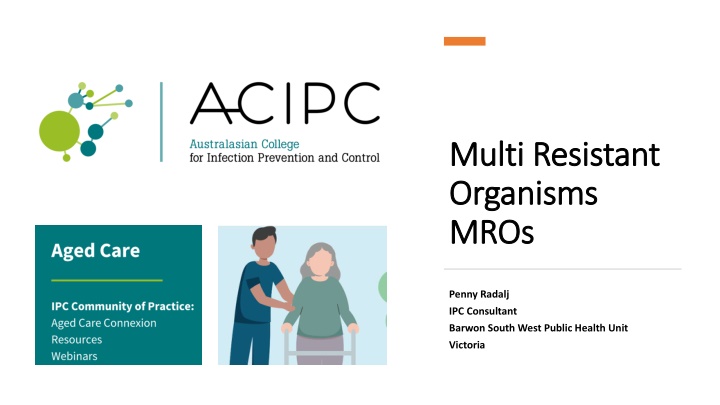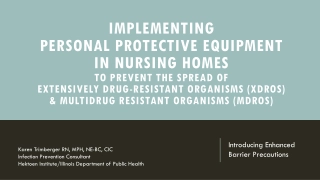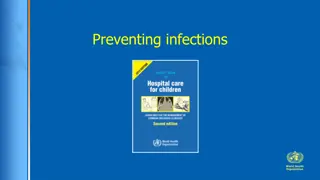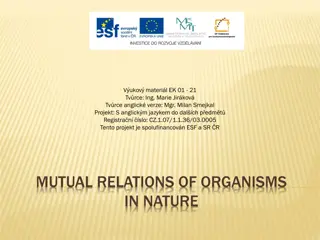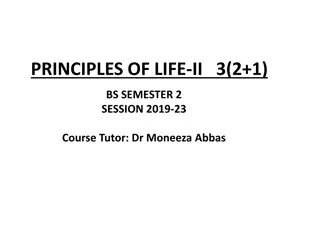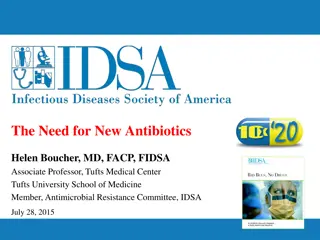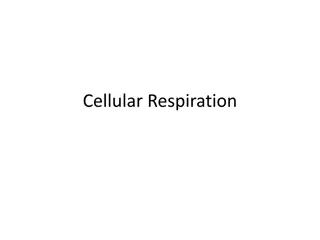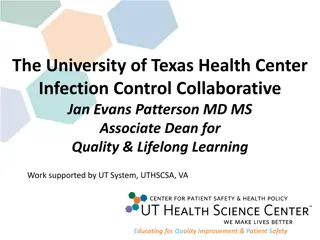Multi-Resistant Organisms in Healthcare
Multi-resistant organisms (MROs) pose a significant threat to global health by developing resistance to antimicrobials. MROs like MRSA, VRE, and MRGN challenge standard treatment methods, leading to prolonged infections and increased morbidity. This article explores the increasing problem of antimicrobial resistance, focusing on Australian Critical AMR monitoring and the emergence of CPE and Candida auris. Learn about the concerns surrounding MROs and the importance of infection prevention and control measures in healthcare settings.
Download Presentation

Please find below an Image/Link to download the presentation.
The content on the website is provided AS IS for your information and personal use only. It may not be sold, licensed, or shared on other websites without obtaining consent from the author.If you encounter any issues during the download, it is possible that the publisher has removed the file from their server.
You are allowed to download the files provided on this website for personal or commercial use, subject to the condition that they are used lawfully. All files are the property of their respective owners.
The content on the website is provided AS IS for your information and personal use only. It may not be sold, licensed, or shared on other websites without obtaining consent from the author.
E N D
Presentation Transcript
Multi Resistant Multi Resistant Organisms Organisms MROs MROs Penny Radalj IPC Consultant Barwon South West Public Health Unit Victoria
ACIPC acknowledges Aboriginal and Torres Strait Island people as the traditional owners of country throughout Australia and ng iwi M ori as the people of the land of Aotearoa and respects their continuing connection to culture, land, waterways, community, and family.
Content Content Introduction Antimicrobial resistance Infection prevention and control Resident care Staff education Communication Summary
Whats the concern What s the concern In the 1940s antibiotics became available, to treat bacterial infections which were previously fatal. Once exposed to antimicrobials (AM), the microorganisms (MO) have an opportunity to develop resistance. Very few antibiotics developed in recent decades. Infections with MROs last longer and cause greater morbidity and mortality. The World Health Organisation states that antimicrobial resistance (AMR) is one of the biggest threats to global health.
What are MROs What are MROs MROs are microorganisms that evolve and develop resistance to an AM that should inhibit or destroy it. These include methicillin-resistant Staphylococcus aureus (MRSA), Vancomycin-resistant enterococci (VRE), multi-resistant Gram-negative bacteria (MRGN), and Clostridiodes difficile (C. diff). Any microorganisms can become resistant and then standard antimicrobial treatment becomes ineffective: challenge to treat infections caused by MROs Use drugs often with increased side effects.
Increasing problem Increasing problem Australian Critical AMRs monitoring (surveillance) Carbapenemase Producing Enterobacteriales (CPE) are a family of bacteria that normally live harmlessly in our bowel e.g. E.coli Among the top AMR threats worldwide because of limited AB options ing in detection Almost of CPE found in people aged > 50 yrs Pseudamonas aeruginosa Major cause of HAIs & ing AMR (naturally resistant to AMs) Enterococcus species Normal GI flora serious infection if they travel to other parts of the body ing AMR Candida auris emerging Candida species ass. with international outbreaks of invasive fungal infections AMR & ing in detection Ref: https://www.safetyandquality.gov.au/publications-and-resources/resource-library/caralert-annual-report-2023
Antimicrobial resistance Antimicrobial resistance The ability of microorganisms to alter themselves so they are unaffected by an antimicrobial that would usually be effective. Natural resistance Intrinsic to the species of microorganism Induced after exposure to an antimicrobial Independent of previous antimicrobial exposure Not related to horizontal gene transfer E.g. enterococci to aminoglycosides, cephalosporins and lincosamides Acquisition of genetic material through horizontal transfer
How AMR moves between microorganisms How AMR moves between microorganisms. Any antimicrobial use can lead to AMR. Antimicrobials kill their target microorganism, but the resistant survivors remain. Resistance traits: Inherited through generations. Pass directly from MO MO by mobile genetic elements.
Mechanisms of resistance Mechanisms of resistance
Risk factors for MROs Risk factors for MROs Hospitalisation or recent health care Living in residential aged care and other communal environments Having developing, waning or compromised immunity e.g. neonates, the elderly, neutropenic people, organ transplant recipients The risk of infection increases with comorbid illness, invasive medical devices, frequent AM exposure and haemodialysis.
MRO and IPC MRO and IPC Antimicrobial stewardship program. Surveillance local and national. Balance risk of transmission against health and wellbeing of the resident. IPC measures focus on transmission pathways. Spread of MROs can occur through person-to-person spread, contact with contaminated objects including shared resident equipment such as medical device/equipment and the facility environment. Understand the risk associated with the microorganism: risk factors with the resident (open wound, cognition, incontinent), the setting and environment single room, shared room and or bathroom, MSU. Standard precautions. Contact transmission based-precautions based on transmission risk assessment. Indwelling devices should be regularly reviewed for their need and removed if no longer required e.g. IDUC.
Standard Precautions Standard Precautions Hand Hygiene Personal protective equipment Safe handling and disposal of sharps Environmental controls (cleaning and spills management) Reprocessing of resusable equipment and instruments Respiratory hygiene (cough etiquette) Aseptic technique Waste and linen management
Transmission Based Precautions Transmission Based Precautions Emphasize consistent practice of standard precautions Risk assess for when contact TBP may be necessary e.g. infection Inside resident s room Continence care Wound care Document and communicate Single use, impervious disposable aprons when entering the room and having contact with residents if soiling is likely e.g. the resident has diarrhoea, if the resident has a discharging wound that cannot be covered by a simple dressing. Discard PPE when leaving the room and perform hand hygiene.
Standard care Standard care Standard precautions, including glove and gown use for contact with uncontrolled secretions, pressure wounds, draining wounds, stool incontinence and ostomy tubes/bags. Single use resident equipment e.g. hoist slings, BP cuffs Clean and disinfect all shared equipment Clean appropriately to the organism Wound management ensure discharging wounds are covered with a dressing to protect the wound and contain discharges. Isolation of the resident with an MRO should be avoided.
Environmental cleaning Environmental cleaning Daily high touch point cleaning in residents rooms/bathrooms utilising both detergent and disinfectant (TGA approved to the organism) products - clean last. Where shared bathrooms are in use, cleaning and disinfection of bathroom must be attended between uses. Routine cleaning of communal areas. Dedicated resident equipment, as possible. Shared equipment cleaning: thorough cleaning/disinfection practices between uses with neutral and disinfectant cleaner/wipe. Routine spill management processes addition of contact precaution PPE if spill is from wound/abscess or cellulitis.
Resident placement Resident placement When single rooms are not available or sharing a room is unavoidable, consider the person sharing the room s vulnerability: Any wounds or indwelling medical devices e.g. IDUC, nutrition tube Underlying health conditions affecting immunity Ability to comply with IPC measures Resident with GI MRO should not be incontinent e.g. CPO, ESBL Shared bathroom used first by unaffected resident Increase cleaning and disinfection of shared room Frequent cleaning and disinfection of bathroom
Participation in group activities and attending Participation in group activities and attending communal areas communal areas Residents with an MRO can continue to participate in group activities unless they are unwell (e.g. diarrhoea). Hand hygiene for all residents before and after attending a group activity. Clean and disinfect all shared equipment. Any oozing wounds should be covered with a dressing that contains the wound ooze. Residents with faecal incontinence can participate in group activities provided they are dressed and wearing a fresh continence pad. Residents can attend a shared dining area and use regular dishes and cutlery. Dishes and cutlery used by residents with an MRO can be processed in the usual manner (e.g.dishwasher) and do not need to be separated.
Staff education Staff education Educate staff about the emerging threat of MROs Stress the importance of IPC precautions Ensure there is a mechanism to notify all staff that a resident requires additional IPC precautions e.g. subtle signage visible on the resident s door any signage used should not disclose the resident s confirmed or suspected diagnosis Conduct in-service education, include all nursing staff or personal care attendants who may provide care to affected resident/s and to all cleaning staff.
Communication and alerts Communication and alerts MRO risk assessment and care plan available in resident notes Communicate to staff their role e.g. extra cleaning MRO consumer information shared with resident and their family Respect resident confidentiality Listen to expressed concerns and speak realistically about risk Involve family and friends (with the resident's consent) Provide residents and families with fact sheets. Review care plan if any changes to resident s health status Alert to notify of MRO status internal and external if transferring resident to a health care facility
Summary Summary Bacteria deal with toxic substances to survive i.e. antimicrobials. This they do very well. Residents may require additional IPC measures. IPC measures should be the least restrictive approach whilst mitigating any ongoing risk. Staff must be educated in MRO and risk mitigation in the residential home. Include the resident and their family in the risk mitigation plan.
References References Aged Care Infection Prevention and Control (IPC) Guide (2024) Australian Guidelines for the Prevention and Control of infection in Healthcare (2019) SHEA/APIC Guideline: Infection Prevention and Control in the Long-Term Care Facility (2008): A broad collection of guidelines relating to Infection Control, Animals in Healthcare facilities, antimicrobial resistance in Long Term Care Facilities (LTCF), urinary tract infections in LTCF. Environmental cleaning and IPC resources: https://www.safetyandquality.gov.au/our-work/infection- prevention-and-control/environmental-cleaning-and- infection-prevention-and-control-resources AIMS Microbiol. 2018; 4(3): 482 501. Published online 2018 Jun 26. doi: 10.3934/microbiol.2018.3.482
